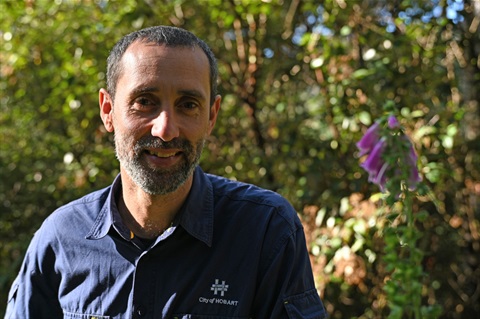
You don't have to walk far from the picnic grounds of Waterworks Reserve to find yourself in a sea of foxglove.
In full bloom infestations on the northern side of the upper reservoir carpet the forest floor in dazzlingly bright colours, but in late March this European plant is at the end of its flowering season and just a few flowers remain.
However, the ground is smothered by foxglove shoots, stalks and leaves, pushing out native grasses and herbs. Only the surrounding eucalypt trees, towering overhead, are out of reach from this environmental weed.
Inch by inch
Grown as an ornamental plant in Tasmanian gardens for generations, foxglove has slowly inched its way into local bushland parks and reserves, and in recent years its spread has exploded across the state, including on many private properties.
So much so that the Tasmanian Government declared it a pest species in February this year, and will target the weed within and around important environmental areas such as the Tasmanian Wilderness World Heritage Area and Wellington Park.
Local action
The decision to list foxglove as a pest species in Tasmania has kickstarted research by the City of Hobart's fire and biodiversity team into what sort of treatment will best control this invasive weed.
We have mapped out a small area of forest just above the northern shoreline of the Upper Reservoir into ten distinct plots. Different herbicides are being used in each plot to help us understand which are most effective in killing foxglove plants, while having minimal impacts on native species.
The results will help us tackle foxglove in key bushland parks and reserves across Hobart, including at Ridgeway and in Waterworks Reserve.
Our research may also help other councils and the Tasmanian Government in their efforts to limit the spread of foxglove across the state.

What's the fuss about?
Once foxglove has invaded a bushland reserve, park or even Tasmania's world-renown Wilderness World Heritage Area, it is very hard to remove.
Its big, bold flowers are perfectly suited to feral bumblebees, which research shows help spread the weed, and may have played a part in the recent explosion of foxglove across Tasmania.
Once foxglove seeds make their way into the soil, they can remain viable for up to 70 years.
Seedlings have been found above 1000 metres on Kunanyi/ Mount Wellington, well into the alpine zone.
Every part of the plant is toxic, not just to agricultural stock, but to humans and pets as well.
Foxglove in gardens
As a declared pest species foxglove can no longer be sold or traded in Tasmania if it produces viable seed. The ban extends to hybrids and cultivars.
Sterile varieties of foxglove are still permitted in Tasmania. If you have foxglove in your garden, first check the Department of Natural Resources and Environment Tasmania Foxglove (Digitalis) webpage to see if your property is in a control area.
Even if it isn’t, we strongly recommend removing foxglove and replacing it with a garden plant variety that has a lower impact on our local environment.
Help us tackle foxglove
For years, the City of Hobart's Bushcare volunteers have waged war against foxglove, fighting to protect the towering forests of Fern Tree and the lush, shaded gulleys of Ridgeway Reserve.
But this relentless invader keeps spreading — and we need everyone to step up and defend our precious bushland.
We strongly urge residents to actively manage foxglove on their land. Effective control involves:
- Plan – Assess infestation and choose appropriate control methods.
- Act early – Control plants before flowering and bag seed heads.
- Follow up – Monitor for regrowth and reapply controls.
- Prevent spread - Dispose of plant material properly and avoid disturbing infested areas during seeding. Inform neighbours if foxglove is present nearby.
For more detailed information on how you can tackle foxglove visit the Tasmanian Government website.